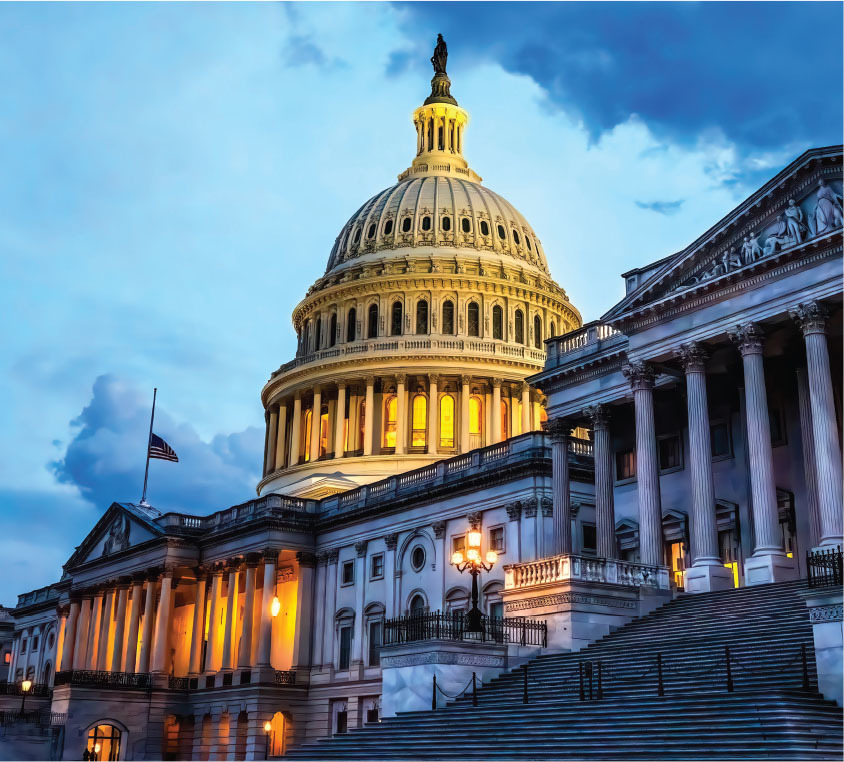October 2014
NSPE TODAY: POLICY PERSPECTIVES
Assessing the 113th Congress
BY ARIELLE EISER
As the 113th Congress draws to a close, PEs have an opportunity to reflect on the achievements and challenges of the past two years as we prepare for the next Congress. Conventional wisdom and press attention has focused on the continued inability of our national legislature to enact major legislative initiatives. Yet, despite the deserved criticism, the 113th Congress has been an important one for professional engineers, both for the bills enacted and the bills introduced.
As regular readers of “Policy Perspectives” know, I have referred to the 113th Congress and 2014 in particular as the “Year of Infrastructure.” The two most significant pieces of infrastructure legislation—the Army Corps of Engineers authorization, known as the Water Resources Reform and Development Act, and the surface transportation authorization, known as Moving Ahead for Progress in the 21st Century Act (MAP-21) —took center stage this Congress.
Last authorized in 2007, WRRDA had long been deferred to address other issues, despite being designed only as a two-year authorization. In a truly rare bipartisan victory and achievement for the engineering community, WRRDA was finally reauthorized, thanks to passage in both chambers of Congress by truly remarkable majorities. NSPE was a strong supporter of this vital legislation and formally endorsed the bill. The legislation set hard deadlines on the time and cost of studies and streamlined environmental reviews. The legislation maximizes the ability of nonfederal interests to contribute their own funds to move authorized studies and projects forward and reduces project backlogs.
As Congress wrapped up WRRDA, the focus shifted to reauthorizing MAP-21 and the Highway Trust Fund. As MAP-21 did not expire until September 30 and the Highway Trust Fund was set to become insolvent as early as August 1, two parallel legislative tracks were pursued. The Senate Environment and Public Works Committee drafted a bipartisan reauthorization of MAP-21 and passed it unanimously out of committee. However, the House Transportation and Infrastructure Committee did not introduce companion legislation and, therefore, no further action was taken. Of more immediate concern was the Highway Trust Fund, a major component of MAP-21. Although full appropriations were authorized for MAP-21 in Fiscal Year 2014, the fund relies on receipts from an 18.4-cent gas tax levied in 1993. Between inflation and more fuel-efficient vehicles, the Highway Trust Fund is on the brink of insolvency.
NSPE launched an action alert campaign and reached an impressive 225 members of Congress to express the urgency of the situation and the importance of not adding to the burden of already underfunded states. Congress subsequently enacted an extension, providing nearly $11 billion to stabilize the fund through May 2015. This was an important and necessary step in the right direction, but Congress must reach a long-term solution in 2015.
Despite the glacial pace of legislative movement in the 113th Congress, this was a very important year for infrastructure and for PEs. NSPE members play a vital role in planning, designing, implementing, constructing, operating, and maintaining infrastructure in all 50 states. Passage of WRRDA and stabilizing the Highway Trust Fund benefits PEs and the public health, safety, and welfare.
While infrastructure was the most active policy issue for PEs in the 113th Congress, there were several other areas of importance to PEs.Chief among these were federal procurement and STEM education. NSPE continued to actively promote qualifications-based selection to congressional offices and underscore the importance of enforcing the federal statutes in place. NSPE also supported and formally endorsed H.R. 2750, the Design-Build Efficiency and Jobs Act of 2013, which addresses the problematic one-step approach to design-build by restricting its use to federal projects less than $750,000. The legislation also requires federal agencies to better justify why they short-list more than five finalists in the two-step design-build process. Introduced by House Small Business Committee Chairman Sam Graves (R-MO), this legislation has gained some traction, particularly in the House, where some of its language was incorporated into the National Defense Authorization Act of 2015. It still remains to be seen if this language will make it into the final conference version between the Senate and the House.
The 113th Congress also saw the introduction of the Educating Tomorrow’s Engineers Act (S. 1178/H.R. 2426), a redesigned version of a K–12 engineering bill that NSPE has long supported. Over the past two years, NSPE has been a leading proponent of the bill on Capitol Hill, garnering substantial bipartisan support in the House. Unfortunately, as this bill would almost certainly be authorized as part of the long overdue next version of the Elementary and Secondary Education Act (ESEA), it has not been enacted in the 113th Congress. However, when the 114th Congress commences, the bill will most likely be reintroduced in a renewed push to include it in ESEA.
The 113th Congress certainly could have achieved far more than it did. Nevertheless, it was an important and productive Congress for professional engineers.
Arielle Eiser is NSPE’s government relations manager.


 Volunteering at NSPE is a great opportunity to grow your professional network and connect with other leaders in the field.
Volunteering at NSPE is a great opportunity to grow your professional network and connect with other leaders in the field. The National Society of Professional Engineers (NSPE) encourages you to explore the resources to cast your vote on election day:
The National Society of Professional Engineers (NSPE) encourages you to explore the resources to cast your vote on election day:



